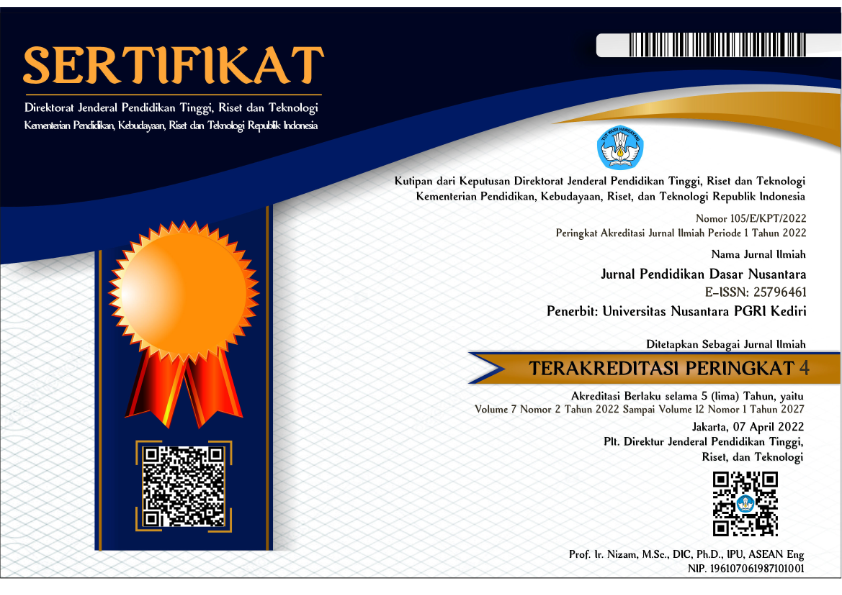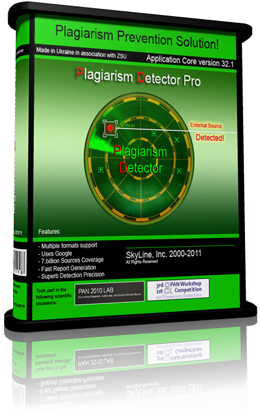PENERAPAN MODEL PEMBELAJARAN QUANTUM TEACHING UNTUK MENINGKATKAN HASIL BELAJAR SISWA PADA MATERI SATUAN LUAS DENGAN ALAT PERAGA SPEKTRUM SATUAN (Studi Kelas V di SDN Betet 3 Kec. Pesantren Kota Kediri)
DOI:
https://doi.org/10.29407/jpdn.v2i1.345Abstract
Abstract: The function and role of the teacher as facilitator and motivator has enormous influence in improving activity and student learning outcomes. The teacher's role in the selection of models, approaches, strategies, techniques and tactics appropriate learning is crucial to the success of student learning. In general, the class V student learning outcomes is still low, less learning activities, passive learning. The average value of the class in the previous KD unsatisfactory at only 62. To overcome these researchers chose Quamtum Teaching learning model which is famous for the term T-A-N-D-N-R. The purpose of this research is to increase the activity and results of learning mathematics in students through a learning model Quamtum Teaching with props Spectra Unit .. While the benefits to be obtained from this study is that this method is expected to increase the activity and student learning outcomes, can be an alternative learning methods in the classroom and learning innovation development
This research is a classroom action research, which is conducted independently. The subjects were 45 students of class V in Betet 3 district. Pesantren - Kediri. The study consisted of two cycles, each cycle consisting of two meetings with the allocation of time for each meeting is 2 x 35 minutes. Data collection techniques using observation and tests. Observation guide used every learning took place, questionnaires and tests used each cycle ends. Interview guides used at the end of the second cycle and field notes made every learning takes place.
Based on the research results, we concluded that the implementation of learning mathematics by using T-A-N-D-u-R (Quantum Teaching) with props "Spectrum" has increased. This is indicated by: (1) Data from observation of learning activities of students has increased from the first cycle to the second cycle dari58,86 to 78 with a high category. (2) average the results of the test cycle that achieve mastery increased, average -rata in the first cycle of 71% increased to 97.7% in the second cycle. (3) From the interviews obtained information that in general students are motivated to learn. Based on data from the observation of the motivation, the result data motivation questionnaire, the average results of the test cycle, and interviews can be concluded that students' motivation increased after learning using T-A-N-D-u-R (Quantum Teaching) with props "Spectrum Unit"
Keywords: Learning Activities, Results Learning, Teaching Quamtum, Spectra Unit.
Abstrak: Fungsi dan peran guru sebagai fasilitator dan motivator memiliki pengaruh yang sangat besar dalam upaya peningkatan aktivitas dan hasil belajar siswa. Peran guru dalam pemilihan model, pendekatan, strategi, teknik dan taktik pembelajaran yang sesuai sangat menentukan terhadap keberhasilan proses belajar siswa. Secara umum hasil belajar siswa kelas V masih rendah, aktivitas belajar kurang, pasif dalam pembelajaran. Nilai rata-rata kelas pada KD sebelumnya kurang memuaskan yaitu hanya 62. Untuk mengatasi hal tersebut peneliti memilih model pembelajaran Quamtum Teaching yang terkenal dengan istilah T-A-N-D-U-R. Adapun tujuan dalam penelitian ini adalah untuk meningkatkan aktivitas dan hasil belajar Matematika pada siswa melalui model pembelajaran Quamtum Teaching dengan alat peraga Spektrum Satuan .. Sedangkan manfaat yang ingin diperoleh dari penelitian ini adalah metode ini diharapkan dapat meningkatkan aktivitas dan hasil belajar siswa, dapat menjadi alternatif metode pembelajaran di kelas dan pengembangan inovasi pembelajaran
Penelitian ini merupakan Penelitian Tindakan Kelas, yang dilaksanakan secara mandiri. Subjek penelitian ini adalah 45 siswa kelas V di Betet 3 Kec. Pesantren – Kota Kediri . Penelitian terdiri dari dua siklus, masing-masing siklus terdiri dari dua kali pertemuan dengan alokasi waktu untuk masing-masing pertemuan adalah 2 x 35 menit. Teknik pengumpulan data menggunakan observasi, dan tes. Pedoman observasi digunakan setiap pembelajaran berlangsung, angket dan tes digunakan setiap siklus berakhir. Pedoman wawancara digunakan pada akhir siklus kedua dan catatan lapangan dibuat setiap pembelajaran berlangsung.
Berdasarkan hasil penelitian, diperoleh kesimpulan bahwa pelaksanaan pembelajaran matematika dengan menggunakan metode T-A-N-D-U-R (Quantum Teaching) dengan alat peraga “Spektrum” mengalami peningkatan. Hal ini ditunjukkan dengan: (1) Data hasil observasi aktivitas belajar siswa mengalami peningkatan dari siklus I ke siklus II dari58,86 menjadi 78 dengan kategori tinggi. (2) Rata-rata hasil tes siklus yang mencapai ketuntasan mengalami peningkatan, rata -rata pada siklus I yaitu 71% meningkat menjadi 97,7% pada siklus II. (3) Dari hasil wawancara diperoleh keterangan bahwa secara umum siswa termotivasi dalam belajar. Berdasarkan data hasil observasi motivasi, data hasil angket motivasi, rata-rata hasil tes siklus, dan hasil wawancara dapat disimpulkan bahwa motivasi belajar siswa meningkat setelah belajar menggunakan metode T-A-N-D-U-R (Quantum Teaching) dengan alat peraga “Spektrum Satuan “
Kata Kunci: Aktivitas Belajar, Hasil Belajar, Quamtum Teaching, Spektrum Satuan.
Downloads
Downloads
Published
Issue
Section
License
Authors who publish with this journal agree to the following terms:
- Copyright on any article is retained by the author(s).
- The author grants the journal, the right of first publication with the work simultaneously licensed under a Creative Commons Attribution License that allows others to share the work with an acknowledgment of the work’s authorship and initial publication in this journal.
- Authors are able to enter into separate, additional contractual arrangements for the non-exclusive distribution of the journal’s published version of the work (e.g., post it to an institutional repository or publish it in a book), with an acknowledgment of its initial publication in this journal.
- Authors are permitted and encouraged to post their work online (e.g., in institutional repositories or on their website) prior to and during the submission process, as it can lead to productive exchanges, as well as earlier and greater citation of published work.
- The article and any associated published material is distributed under the Creative Commons Attribution-ShareAlike 4.0 International License

































